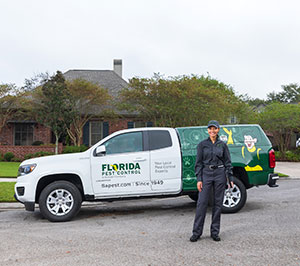Bed Insect Treatment Malfunction: Comparing Chemical Vs. Non-Chemical Solutions
In the world of insect control, particularly when managing the persistent problem of bed pests, the choice in between chemical and non-chemical therapy solutions can be an essential one. Both methods supply distinct advantages and downsides, influencing aspects such as effectiveness, security factors to consider, and overall price. By checking out the nuanced details of each technique, a more clear understanding of which course to pursue in addressing a bed bug invasion can be obtained.
Efficiency of Chemical Treatments
Chemical therapies for bed bug invasions have actually been commonly acknowledged for their quick and powerful efficacy in removing these parasites. When considering the efficiency of chemical treatments, it is important to recognize that they can offer a detailed and quick service to a bed bug problem. Professional pest control experts usually depend on pesticides to target bed bugs at different phases of their life cycle, consisting of eggs, fairies, and grownups. These chemicals usually function by disrupting the bed bugs' nervous system, leading to paralysis and eventual fatality.
Moreover, chemical treatments have the benefit of providing residual impacts, indicating that they can remain to remove bed insects also after the initial application. This residual activity is especially advantageous in combating any kind of possible re-infestations. In addition, the fast activity of chemical treatments can bring alleviation to individuals dealing with severe bed pest invasions, permitting them to regain control of their home rapidly.
Safety Interest In Chemical Solutions
One vital element that needs cautious consideration when using chemical options for bed bug treatment is making sure the security of residents and the atmosphere. Exposure to particular chemicals made use of in bed pest treatments can lead to breathing issues, skin irritation, or various other negative responses, particularly in individuals with pre-existing problems or sensitivities.
Moreover, the ecological effect of chemical options is one more considerable consideration. Some pesticides made use of in bed pest therapies may be damaging to beneficial bugs, wild animals, and environments if they leach into the dirt or water systems. It is necessary to use chemical therapies carefully, complying with safety guidelines, and thinking about less poisonous options to reduce these threats and ensure the efficient and safe monitoring of bed bug problems.
Benefits of Non-Chemical Techniques
Taking into consideration the possible safety worries and ecological impact connected with chemical solutions for bed pest therapy, checking out non-chemical strategies provides a promising alternative with a number of distinctive advantages. Non-chemical methods use a safer alternative for houses, especially those with kids, pets, or individuals conscious harsh chemicals. These methods eliminate the risks of direct exposure to toxic substances, minimizing the potential for negative health impacts. Furthermore, non-chemical treatments are ecologically pleasant, as they do not add to right here air or water pollution, making them a sustainable selection for pest control.
Additionally, non-chemical services can be efficient in targeting bed insects, consisting of hard-to-reach locations where chemical therapies might not permeate. Techniques such as heat therapy, vacuuming, heavy steam cleansing, and cushion coverings supply extensive obliteration without the usage of harmful chemicals. Furthermore, non-chemical methods can be less disruptive, needing marginal prep work and permitting quicker reentry into treated areas. In general, choosing non-chemical bed pest therapy techniques not only prioritizes safety and security and ecological protection yet likewise makes sure extensive and effective parasite control.
Limitations of Non-Chemical Treatments

Furthermore, non-chemical therapies usually require numerous applications to achieve successful elimination. This can be taxing and may not always assure complete elimination of all bed pests and their eggs, specifically in hard-to-reach or surprise areas.
Furthermore, the success of non-chemical treatments greatly relies upon correct application and thoroughness, which can be testing for individuals without professional competence. Poor application of non-chemical approaches might cause insufficient obliteration, resulting in consistent invasions and the requirement for extra treatments.
For that reason, while non-chemical treatments have their advantages, it is necessary to recognize these constraints and consider them when establishing one of the most reliable strategy for taking care of bed pest invasions.
Expense Comparison: Chemical Vs. Non-Chemical Options
Given the constraints associated with non-chemical therapies, an important facet to examine in the context of bed bug management is the expense contrast between chemical and non-chemical choices. In comparison, non-chemical treatments like warm therapy or heavy steam can be extra pricey, with expenses varying from $1,000 to $6,000 for an entire home. While the preliminary price of chemical treatments might seem reduced, multiple treatments may be called for to totally eliminate the invasion, possibly increasing the general expense.
Final Thought

Thinking about the possible safety and security issues and ecological impact associated with chemical options for bed pest treatment, checking out non-chemical approaches presents an encouraging option with several distinctive advantages.Given the limitations connected with non-chemical treatments, a vital facet to assess in the context of bed insect monitoring is the cost contrast between chemical and non-chemical options. In comparison, non-chemical therapies like warm therapy or vapor can be extra expensive, with prices varying from $1,000 to $6,000 for a whole home. While the first price of chemical therapies might appear lower, multiple treatments may be required pest control agency to fully eradicate the infestation, potentially increasing the overall price.In verdict, when contrasting chemical and non-chemical bed insect therapy alternatives, it is essential to think about performance, security, benefits, constraints, and cost.